4×4 Raised Bed Layout Ideas for a Vegetable Garden
Previously we have looked at planting layouts for 8x4ft raised garden beds. Generally, this size raised bed tends to work well, but you sometimes need to use smaller-sized beds such as 4x4ft in smaller gardens or awkward gardens.
Below we have put together a series of layouts for 4x4ft raised beds that should give you some planting ideas to help you maximize your space and grow various delicious vegetables. The layouts cater to different gardening styles and preferences, hopefully, they will allow you to find the perfect configuration for your needs.
Layout 1: Classic Square
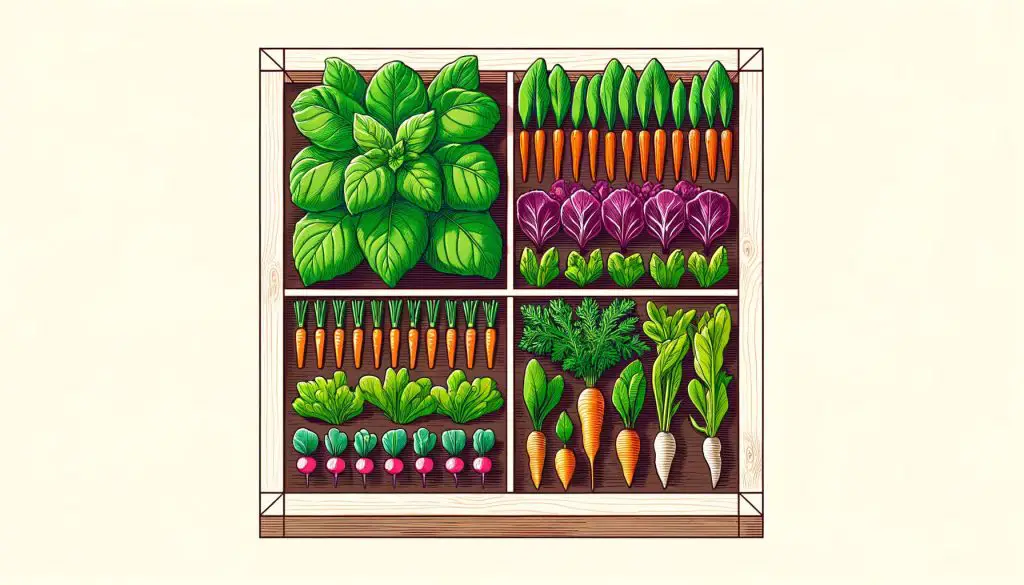
This layout is ideal for beginners and those who prefer a straightforward approach. It features four rows of vegetables, with each row dedicated to a specific type of crop.
- Row 1: Tomatoes (2 plants)
- Row 2: Leafy greens (lettuce, kale, spinach) (4 plants)
- Row 3: Carrots (8 plants)
- Row 4: Radishes (8 plants)
Layout 2: Companion Planting
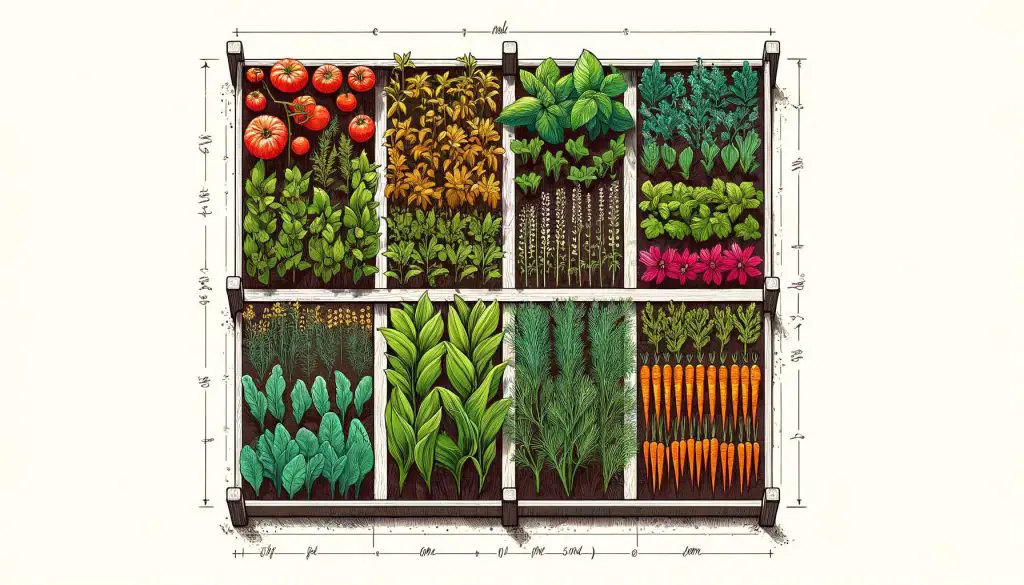
This layout takes advantage of the benefits of companion planting, where certain vegetables are paired to enhance growth, flavor, or pest resistance.
- Row 1: Tomatoes (2 plants) with basil (4 plants)
- Row 2: Cucumbers (2 plants) with dill (4 plants)
- Row 3: Carrots (8 plants) with sage (4 plants)
- Row 4: Radishes (8 plants) with beans (4 plants)
Layout 3: Intensive Planting
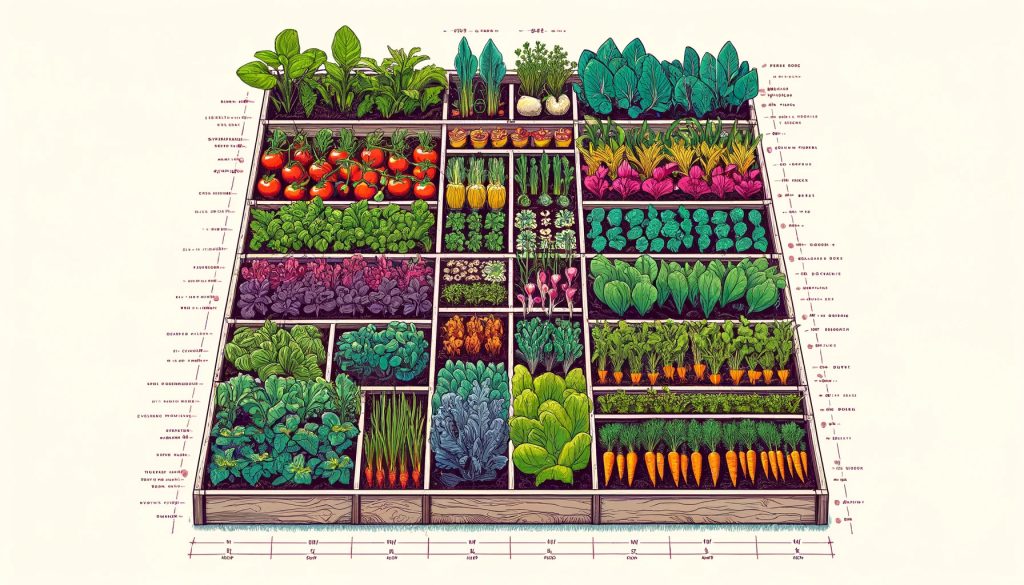
This layout is perfect for those who want to grow a variety of vegetables in a small space. It features a dense planting pattern to maximize yield.
- Row 1: Tomatoes (4 plants) with basil (8 plants)
- Row 2: Leafy greens (lettuce, kale, spinach) (8 plants)
- Row 3: Carrots (16 plants)
- Row 4: Radishes (16 plants)
Layout 4: Vertical Gardening
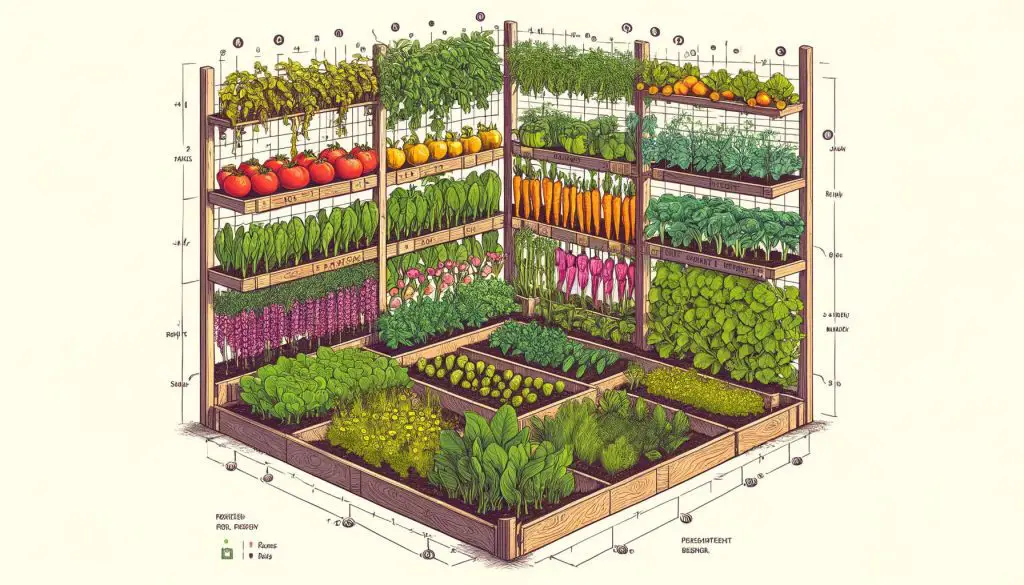
This layout incorporates trellises and other vertical supports to make the most of your raised bed’s vertical space.
- Row 1: Tomatoes (2 plants) with basil (4 plants) and a trellis for peas
- Row 2: Cucumbers (2 plants) with dill (4 plants) and a trellis for beans
- Row 3: Carrots (8 plants) with sage (4 plants) and a trellis for climbing peas
- Row 4: Radishes (8 plants) with beans (4 plants) and a trellis for climbing beans
Layout 5: Mixed Crop
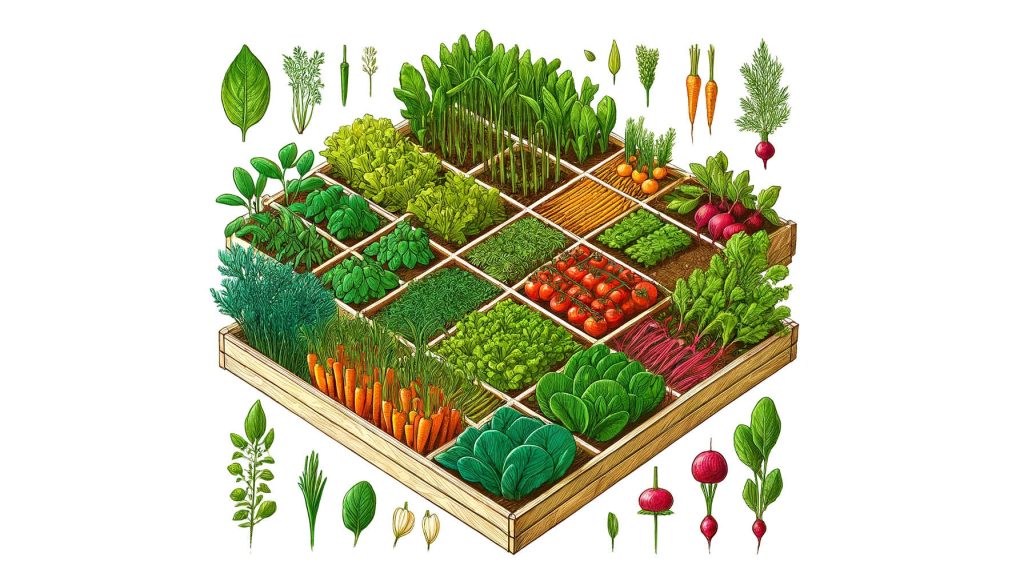
This layout combines different vegetables and herbs in a single row, creating a diverse and thriving ecosystem.
- Row 1: Tomatoes (2 plants), basil (4 plants), and carrots (4 plants)
- Row 2: Leafy greens (lettuce, kale, spinach) (8 plants), radishes (8 plants), and sage (4 plants)
- Row 3: Cucumbers (2 plants), dill (4 plants), and beans (4 plants)
- Row 4: Carrots (8 plants), radishes (8 plants), and beans (4 plants)
These layouts offer a range of options for 4x4ft raised beds, catering to different gardening styles and preferences. Whether you’re a beginner or an experienced gardener, you’re sure to find a configuration that suits your needs and helps you grow a thriving and productive vegetable garden.
More creative Planting Combination
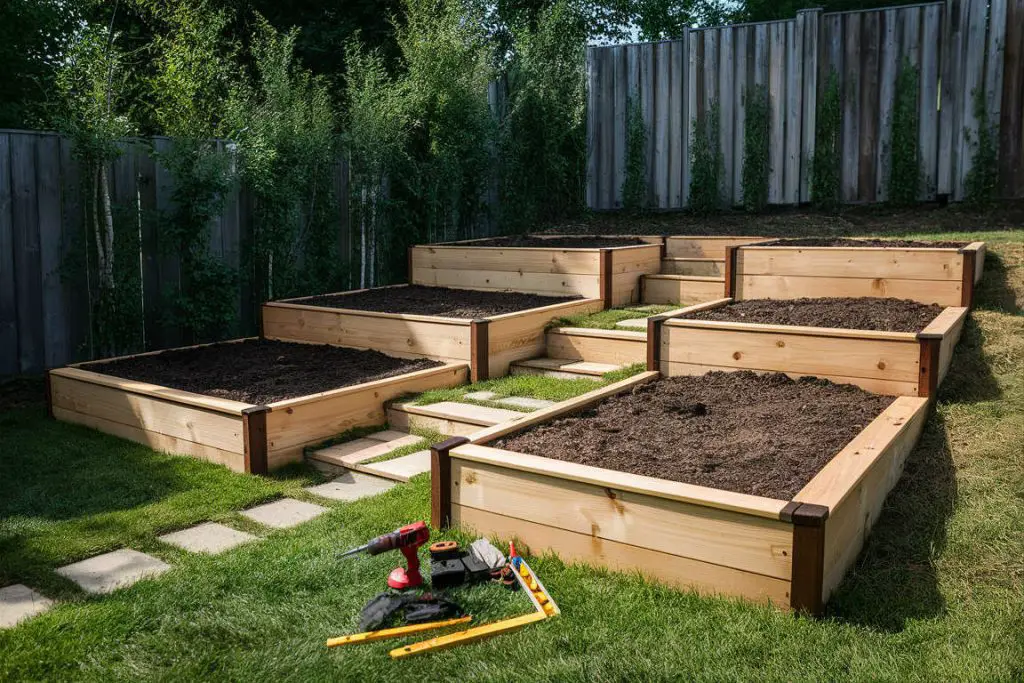
If you are looking to be a little bit more adventurous with your planting then here are some creative plant combinations that can help maximize space and promote healthy growth:
- Tomatoes and Basil: Plant two tomato plants with a row of basil in between. This combination not only looks beautiful but also enhances the flavor of the tomatoes and repels pests.
- Peas and Cucumbers: Combine sugar snap peas and snow peas with cucumbers. The peas will provide shade for the cucumbers, and the cucumbers will help keep the peas upright. This combination also benefits from companion planting, reducing pests and diseases.
- Carrots and Sage: Plant carrots with sage, which repels carrot flies and other pests. The sage also adds a fragrant flavor to the carrots when cooked together.
- Radishes and Beans: Combine radishes with beans, which help to repel pests that target beans. Radishes also improve soil health and can be harvested quickly to make room for the beans.
- Leafy Greens and Marigolds: Plant a mix of leafy greens like lettuce, kale, and spinach with marigolds. Marigolds repel nematodes and other pests that target leafy greens, while the greens provide a beautiful display of color and texture.
- Herbs and Flowers: Combine herbs like thyme, rosemary, and oregano with flowers like zinnias, sunflowers, or marigolds. This combination adds visual interest and fragrance to the garden while also promoting beneficial insects and pollinators.
- Vining Plants: Use trellises or obelisks to support vining plants like peas, beans, or tomatoes. This maximizes vertical space and allows for a greater variety of plants in a small area.
- Companion Planting: Plant different vegetables and herbs together based on their complementary growth habits and pest-repellent properties. For example, plant marigolds with vegetables to deter pests, or plant basil with tomatoes to enhance flavor.
These creative plant combinations can help you make the most of your 4x4ft raised bed, promoting healthy growth, reducing pests and diseases, and adding visual interest to your garden.
General Tips for Vegetable Gardening in Small Raised Beds
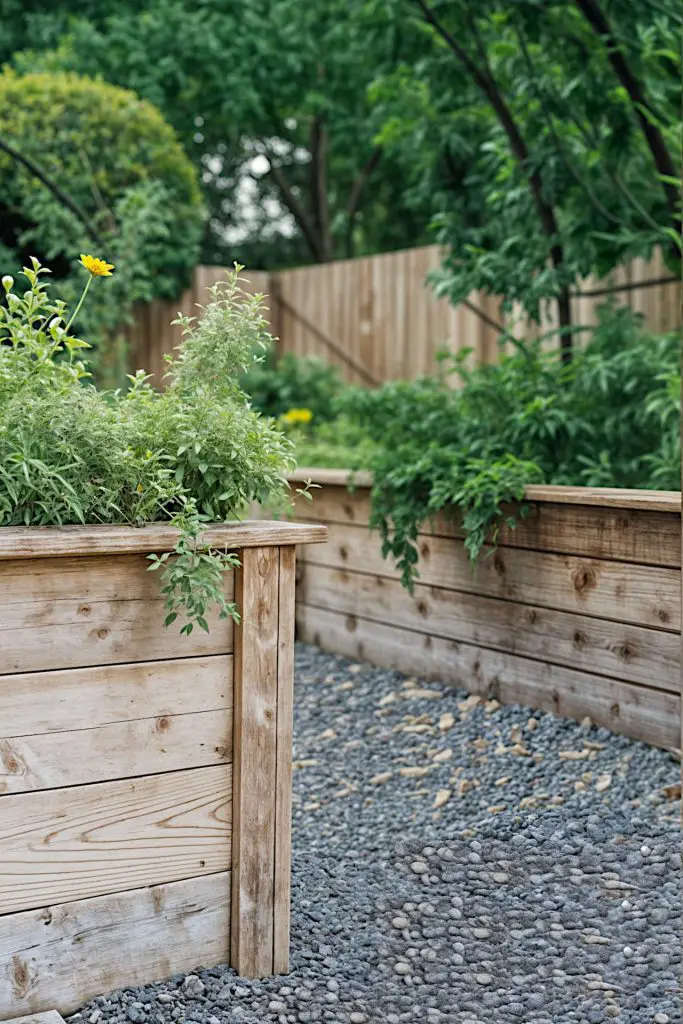
Starting a vegetable garden in a small raised bed can be both rewarding and efficient. These compact gardens allow for better soil control, improved drainage, and easier access for maintenance. Whether you’re a seasoned gardener or a beginner, these tips will help you maximize the potential of your small raised bed garden.
Choose the Right Location
Ensure your raised bed receives at least six to eight hours of sunlight daily. Most vegetables thrive in full sun, so pick a spot that isn’t shaded by trees or buildings.
Plan Your Layout
Organize your plants according to their height and growth habits. Taller plants, such as tomatoes or beans, should be placed at the back or center of the bed, while shorter plants like lettuce or carrots can be at the front. This arrangement prevents taller plants from shading shorter ones.
Optimize Soil Quality
Fill your raised bed with high-quality soil that is rich in organic matter. A mix of garden soil, compost, and well-rotted manure works well. Good soil structure ensures proper root development and nutrient availability.
Practice Crop Rotation
Avoid planting the same vegetable in the same spot each year. Rotate your crops to prevent soil-borne diseases and pests from becoming established. This practice also helps in maintaining soil fertility.
Use Companion Planting
Certain plants grow better together. For example, planting basil near tomatoes can enhance their flavor and deter pests. Research companion planting to find beneficial plant pairings for your raised bed.
Water Efficiently
Raised beds can dry out faster than traditional gardens. Water your plants deeply and consistently, preferably in the early morning or late afternoon to minimize evaporation. Consider installing a drip irrigation system for more efficient watering.
Mulch Generously
Applying a layer of mulch helps retain soil moisture, suppress weeds, and regulate soil temperature. Organic mulches like straw, leaves, or grass clippings are excellent choices for vegetable gardens.
Keep an Eye on Pests
Regularly inspect your plants for signs of pests or disease. Early detection and prompt action can save your crops. Use organic pest control methods, such as neem oil or insecticidal soap, to manage any issues.
Maximize Planting Space
To maximize space in a 4x4ft raised bed, consider the following strategies:
- Square Foot Gardening: Divide the bed into 1-foot sections and plant different crops in each section. This technique allows for efficient use of space and can accommodate a variety of plants.
- Companion Planting: Pair plants that have complementary growth habits or pest-repellent properties. For example, planting marigolds alongside vegetables can help deter pests.
- Vertical Gardening: Incorporate trellises or obelisk supports to grow vining plants like peas, beans, or tomatoes. This adds vertical space and increases the overall yield.
- Crop Selection: Choose compact or dwarf varieties of plants that are well-suited for small spaces. These plants will require less space and can be more productive in a 4x4ft bed.
- Proper Plant Spacing: Ensure that plants are spaced correctly to avoid overcrowding. Refer to the seed packet or plant label for specific spacing recommendations.
- Soil Quality: As mentioned above, use high-quality soil that is well-draining and rich in nutrients. This will promote healthy plant growth and maximize the bed’s potential.
Maintain Consistent Care
Regularly weed, water, and fertilize your raised bed garden. Consistent care ensures that your plants remain healthy and productive throughout the growing season.
